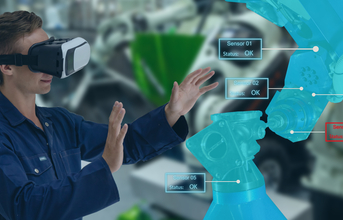
The line between the physical and digital worlds has been shrinking ever since the digital wave disrupted our daily functions and markedly transformed. With every physical task augmented with real-time digital experience, it is becoming impossible to keep the physical and digital worlds apart. The push by an unexpected pandemic and the prolific technological adoption across the entire industrial ecosystem has, in turn, accelerated the 4th industrial revolution, making technology the fulcrum of every process.
Significant breakthroughs in emerging technologies - Artificial Intelligence (AI), Robotic Process Automation (RPA), Nanotechnology, the Internet of Things (IoT), Autonomous Vehicles, 3D Printing, Biotechnology, Materials Science, Quantum Computing, Blockchain, and Predictive Analysis have brought in the concept of immersive experiences. As a result, human behaviour is interpreted at every touchpoint to tailor better experiences, minimise error and deliver optimised outcomes that aim at improving customer experience and contributing to increased revenue.
This technological hypergrowth has been very beneficial for the factory set-up. Heavy goods manufacturing units and factories are redefining their technical framework by using Big Data, Blockchain, AR/VR and Robotic Process Automation (RPA) to maintain the demand-supply balance, bring more transparency to the system, identify system challenges easily and come up with possible solutions just in time.
The Role Of Co-bots In Manufacturing Set-ups
Manufacturing firms are moving towards their vision of smart factories and investing billions in RPA and IoT. Over the next few years, most of these firms seek to improve their shop-floor productivity and supply chain efficiency. In addition, they aim to move beyond the shop floors and create a wholesome experience for their end customers with minimal human intervention.
Non-production processes like customer service, HR, finance, procurement, administration and overall employee knowledge management, which didn't get much attention, have now become the prime focus for process automation and ai. Collaborative robots, also known as co-bots, provide automated solutions designed to work with and alongside the human workforce. They are increasingly capable of performing every task under the roof and are strategised to carry out repetitive tasks daily. Furthermore, they can work alongside the human workforce, making their jobs easier by completing monotonous or physically demanding tasks. This not only leads to better productivity but is also economically viable.
Simulation Modelling And AR/VR For A Holistic View
With continuous evolution comes the pressure of staying relevant in a world of heightened competition. Conquering newer market segments and adapting to the latest trends has become necessary for manufacturers. This is where Simulation Modelling and AR/VR contribute to a smart set-up.
The simulation method helps to understand and predict the nature of specialised actions in the design stage itself, making it easier for businesses to identify loopholes in the concept beforehand. Furthermore, a strategic combination of simulation modelling and AR/VR helps optimise manufacturing processes, enhancing supply, inventory management, and production. As predicted by MarketsandMarkets, the AR market will grow at the rate of 46.6 per cent annually, reaching $72.7 billion by 2024. These technological concepts revolutionise industry capabilities from knowledge management to maintenance and product developments.
Introduction To Intelligent Factory
According to BCG, the intelligent factory or factory of the future is bringing major improvements in three primary dimensions of plant structure, plant digitisation, plant processes and consolidation to enhance production.
Three key enablers to building one such intelligent factory are strategy and leadership, upgraded employee skills and IT infrastructure. For the materialisation of the intelligent factory, manufacturers need plant-wide connectivity using cloud solutions and robust technology to capture and store production data.
The next key ingredient is data security once the pace is set with good infrastructure. For a seamless operation, data needs to flow free of any friction. Therefore, data security is integral to augmenting supply chain processes across the industry.
Role Of Additive Manufacturing In An Intelligent Factory
Mass production of essential components - fabrication of functional prototypes, directly generating prints from the CAD data, and making the entire design system frictionless, additive manufacturing is an all-inclusive concept that helps design, develop, and build heavy industrial applications, and 3D printing is an integral part. Moreover, when implemented with a clear objective and aligned to business processes, additive manufacturing aids in cost-saving, reduces assembly times, and simplifies supply chains. This implies that factories can aim for optimal process efficiency with a minimal human touch, thus creating a future factory.
Need For Enhanced Cybersecurity
Since these integrated factories are operating with high volume data, as mentioned above, cyber security enhancement is an area of high priority. Furthermore, due to the always-connected nature of the plants and data exchange happening at all the operational points, having any loose end could prove to be a threat and lead to a higher possibility of a data breach.
It is important to ensure that every process goes under the scanner of relevant cyber laws and guidelines for healthy operations. Also, building robust cybersecurity capabilities, keeping in mind the business-critical systems, are essential for long-term success without data compromise.
5G Network & Its Centrifugal Role In Elevating Industry 4.0
Along with technological advancements, the communication infrastructure is always on continuous improvement. Therefore, the growth and development of 5G directly impact the operation and scaling of a smart factory. Its ability to deploy customised services and automated applications will help the future factory bring precision to production processes, synchronised supply chains and improved efficiency.
5G's upgraded capabilities, including programmability and near zero latency, are predicted to give rise to new networks and services, allowing a widespread deployment of automated processes. In light of 5G networks, Industry 4.0 is continuing to advance, and automated management systems are already operational across the landscape.


























